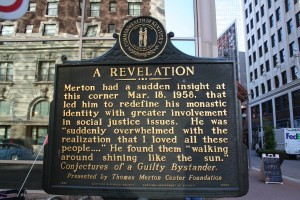
In the middle of downtown Louisville, Kentucky, there stands a very unusual bronze plaque. Most such markers commemorate a battle, political figure, or some natural or historical feature. The one on the street corner in Louisville marks a mystical experience—one that happened to the monk Thomas Merton on March 18, 1958:
“In Louisville, at the corner of Fourth and Walnut, in the center of the shopping district, I was suddenly overwhelmed with the realization that I loved all those people, that they were mine and I theirs, that we could not be alien to one another even though we were total strangers….There is no way of telling people that they are all walking around shining like the sun.”
That marker points to the intriguing paradox of Merton’s life. For 26 years he was a Trappist monk, a member of one of the strictest of all orders and resident of a quiet rural monastery. But Merton was also a citizen of the world, passionately engaged in the political dialogues of his day, writing books that were avidly read by millions across the globe, and corresponding by letter with thousands of people. He was both beloved and the subject of controversy. So that plaque marking an interior experience, located on one of the busiest intersections in the city, is an apt symbol of the paradoxical strains of Merton’s life.
When I think of my recent trip following in Merton’s footsteps, I keep coming back to that marker. I know of nothing else quite like it. Where else can you find a tourist plaque honoring a mystical experience? Its existence points to Merton’s influence and importance as well as to the contradictions of his life.
The Holy Rover is going to spend a number of days with Merton, for really, there is so much to learn from him. But for today, just look at his photo. I’ve long thought that people who have delved deep in spiritual matters have a certain look in their eyes. You can see it in the face of the Dalai Lama, for example, and Pope John Paul II. There’s a deep joy there, despite what they’ve had to endure. They have something to teach us, do they not?











